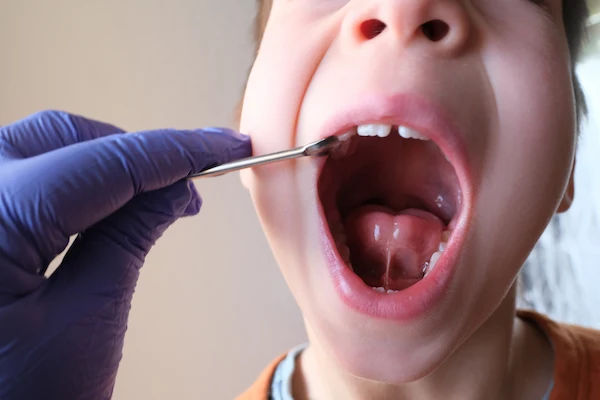Understanding Tongue Tie: Causes, Symptoms, and Treatment
Learn about the causes, symptoms and treatment options for tongue tie. This comprehensive guide explains everything about the condition, helping you make informed decisions for better oral health.

Written by Dr.Sonia Bhatt
Last updated on 3rd Jul, 2025

Tongue tie, medically known as ankyloglossia, is a condition where the tongue’s movement is restricted due to a tight or short lingual frenulum—the small band of tissue connecting the tongue’s underside to the floor of the mouth. While some individuals live with mild cases without issue, others face challenges with feeding, speech, and oral health. This blog explores everything you need to know about tongue tie, to help you make informed decisions for yourself or your child.
Causes and Risk Factors of Tongue Tie
It is unknown what precisely causes tongue tie, but a range of both genetic and developmental factors can lead to the condition. Knowledge of these enables parents and individuals to identify the potential risks and seek timely intervention.
1. Genetic Factors
Genetics play a significant role in tongue tie. If a parent or sibling has had tongue tie, the likelihood of a newborn having the condition increases. Certain genes may influence the development of the lingual frenulum during foetal growth.
Family History: Families with a history of tongue tie often see the condition recur across generations. This suggests a hereditary component, though the exact genes involved are still under investigation.
2. Developmental Factors during Pregnancy
During foetal development, the lingual frenulum naturally separates from the tongue, allowing for greater mobility. In cases of tongue tie, this separation is incomplete, leaving the frenulum shorter, thicker, or tighter than usual.
Incomplete Separation: Normally, the frenulum thins and recedes as the baby grows in the womb. In tongue tie, this process is disrupted, resulting in restricted tongue movement.
Timing of Development: The frenulum forms early in pregnancy, and any disruption during this critical period may contribute to tongue tie.
3. Associated Conditions and Risk Factors
While tongue tie can occur in isolation, it is sometimes associated with other medical conditions or syndromes. These associations can help identify individuals at higher risk.
Cleft Lip or Palate: Babies born with cleft lip or palate are more likely to have tongue tie. This is because both conditions involve disruptions in the development of oral structures.
Genetic Syndromes: Certain genetic disorders, such as Ehlers-Danlos syndrome (a connective tissue disorder) are linked to a higher incidence of tongue tie.
Other Oral Anomalies: Conditions like a high-arched palate or lip tie (where the upper lip is tightly tethered) may co-occur with tongue tie.
4. Environmental and Prenatal Factors
While less understood, some environmental and prenatal factors may contribute to the development of tongue tie. These include:
Maternal Health: Conditions like gestational diabetes or folate deficiency during pregnancy may influence foetal development, though evidence is limited.
Exposure to Toxins: Exposure to certain chemicals or medications during pregnancy could play a role.
Consult Top Otolaryngologist
Signs and Symptoms of Tongue Tie by Age
Symptoms vary depending on age and severity:
In Babies: Breastfeeding difficulties: Poor latch, slipping off the breast, or prolonged feeds.
Signs in mothers: Sore/cracked nipples, low milk supply, or mastitis.
In Children: Speech delays: Trouble pronouncing “t,” “d,” “s,” or “r” sounds.
In Adults: Persistent speech issues: Mumbling or unclear speech.
How is Tongue Tie Diagnosed?
Diagnosing tongue tie involves a combination of physical examination and assessing how the condition affects daily activities like feeding, speech, and oral health. Here’s a brief guide on how tongue tie is diagnosed.
Several healthcare professionals can diagnose tongue tie, including:
Paediatricians: For infants and young children.
Lactation Consultants: If breastfeeding difficulties are present.
ENT (Ear, Nose, and Throat) Specialists: For more complex cases.
Dentists or Orthodontists: If dental issues are a concern.
Speech Therapists: For older children or adults with speech problems.
1. Physical Examination
The first step is a visual and hands-on check of the tongue and frenulum. The healthcare provider will:
Look under the tongue: They’ll check where the frenulum is attached (near the tip or further back) and how thick or tight it is.
Test tongue movement: They’ll ask you or your child to lift the tongue up to the roof of the mouth, stick the tongue out as far as possible and move the tongue side to side.
For babies, this is done gently and quickly, often during a routine check-up or if feeding problems are reported.
2. Functional Assessment
A tight frenulum doesn’t always cause problems, so the doctor will also evaluate how it affects function:
For Infants:
Difficulty latching or staying latched.
Clicking sounds during feeding.
Poor weight gain or very long feeding sessions.
Painful or damaged nipples for the mother.
Milk leakage, gagging, or excessive air intake.
For Older Children and Adults:
Speech Difficulties: Trouble pronouncing certain sounds like “t,” “d,” “s,” or “l.”
Eating Challenges: Difficulty chewing, swallowing, or managing certain foods.
Dental Issues: Gaps between teeth, gum problems, or tongue thrusting.
3. Using Assessment Tools
Some clinicians use standardised tools to evaluate tongue tie:
Hazelbaker Assessment Tool: Scores the appearance of the frenulum (e.g., elasticity, attachment) and its functional impact (e.g., tongue lift, extension).
Coryllos Classification: Grades tongue tie from Type I (mild) to Type IV (severe) based on where the frenulum attaches.
Common Challenges in Diagnosis
Posterior Tongue Tie: This type is harder to spot because the frenulum is thicker and located deeper under the tongue. It’s often missed in basic exams.
Misdiagnosis: Symptoms like feeding difficulties or speech delays can sometimes be caused by other issues, such as low muscle tone or sensory problems.
Lack of Awareness: Not all healthcare providers are trained to recognise tongue tie, especially in older children or adults.
When to Seek Help
If you notice any of the following, ask for a tongue tie evaluation:
In Infants: Struggles with breastfeeding or bottle-feeding or poor weight gain or excessive fussiness during feeds.
In Older Children: Speech delays or unclear pronunciation.
In Adults: Jaw pain, neck strain, or sleep apnea or embarrassment over speech or eating habits.
Post Diagnosis Treatment
If tongue tie is diagnosed, the healthcare provider will discuss treatment options, which may include:
No treatment: If the tongue tie is mild and not causing problems.
Frenotomy: A quick procedure to snip the frenulum (common for infants).
Speech or Myofunctional Therapy: Exercises to improve tongue movement and strength.
Conclusion
Tongue tie, or ankyloglossia, is a condition that can affect individuals of all ages, from newborns struggling with breastfeeding to adults facing speech or dental challenges. While the causes are often linked to genetics and developmental factors, the symptoms vary widely depending on age and severity. Early diagnosis is key to preventing long-term complications, and treatment options like frenotomy or speech therapy can significantly improve quality of life. If you suspect tongue tie in yourself or your child, don’t hesitate to seek an evaluation from a qualified healthcare professional. With timely intervention and the right support, individuals with tongue-tie can overcome its challenges and thrive. Remember, understanding the condition is the first step toward finding effective solutions.
Consult Top Otolaryngologist
Consult Top Otolaryngologist

Dr. Putta Sai Sahiti
Dentist
8 Years • MDS (Pediatric & Preventive Dentistry)
Hyderabad
D32 Dental & Maxillofacial Centre, Hyderabad
Dr Parul Chandra
Dentist
25 Years • BDS
Noida
Chandra Cosmetic Dental Center, Noida

Dr. Ankit Khandelwal
Oral and Maxillofacial Surgeon
13 Years • BDS, MDS ( Oral & Maxillofacial Surgery) , PGDCC, Fellowship in Head & Neck Oncology
Kolkata
Gajanan Multispeciality Clinic, Kolkata
(75+ Patients)

Dr. Spandan Daschowdhury
Dentist
2 Years • BDS
Kolkata
MCR SUPER SPECIALITY POLY CLINIC & PATHOLOGY, Kolkata

Dr. Gourab Paul
Oral and Maxillofacial Surgeon
5 Years • BDS,MDS(ORAL AND MAXILLOFACIAL SURGERY)
Kolkata
SOLACE OF SOULS(SOS) HEALTH CARE, Kolkata
(25+ Patients)
Consult Top Otolaryngologist

Dr. Putta Sai Sahiti
Dentist
8 Years • MDS (Pediatric & Preventive Dentistry)
Hyderabad
D32 Dental & Maxillofacial Centre, Hyderabad
Dr Parul Chandra
Dentist
25 Years • BDS
Noida
Chandra Cosmetic Dental Center, Noida

Dr. Ankit Khandelwal
Oral and Maxillofacial Surgeon
13 Years • BDS, MDS ( Oral & Maxillofacial Surgery) , PGDCC, Fellowship in Head & Neck Oncology
Kolkata
Gajanan Multispeciality Clinic, Kolkata
(75+ Patients)

Dr. Spandan Daschowdhury
Dentist
2 Years • BDS
Kolkata
MCR SUPER SPECIALITY POLY CLINIC & PATHOLOGY, Kolkata

Dr. Gourab Paul
Oral and Maxillofacial Surgeon
5 Years • BDS,MDS(ORAL AND MAXILLOFACIAL SURGERY)
Kolkata
SOLACE OF SOULS(SOS) HEALTH CARE, Kolkata
(25+ Patients)
